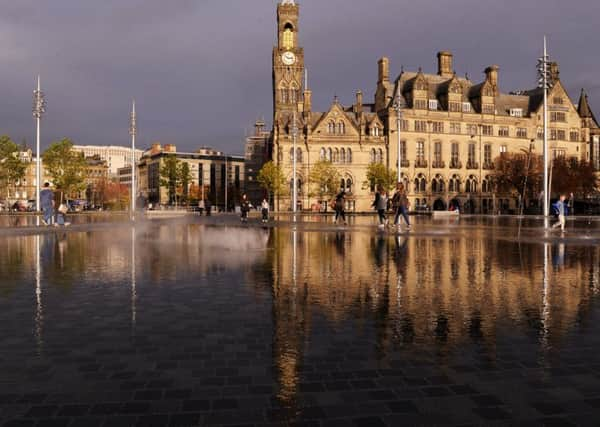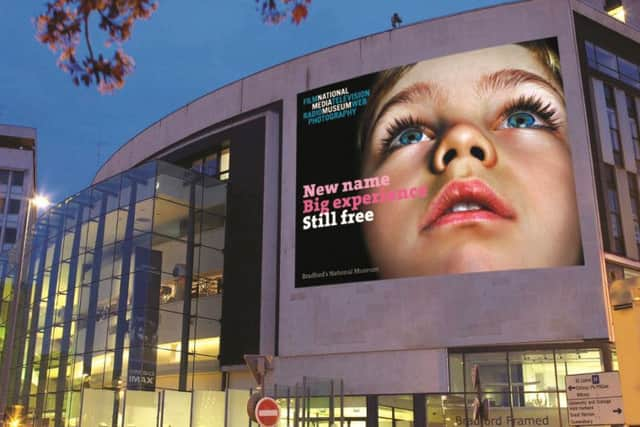Bradford: Is this a city on the rise?


LAST November, I looked out across the centre of Bradford on a cold, miserable afternoon surrounded by a sea of metal frames.
Twelve months on and this skeleton has been transformed into a sparkling new shopping complex. To say that the £260m Broadway scheme has been long-awaited is a gross understatement. But today it finally opens and in doing so not only brings a string of big name retail brands to Bradford, it also fills, both physically and emotionally, the 10-acre hole that blighted the city centre for so long.
Advertisement
Hide AdAdvertisement
Hide AdBroadway has been billed as a symbol of Bradford’s regeneration, but it is not alone. The £24.5m City Park, a scaled-down version of Will Alsop’s vision of a giant lake in the heart of the city, has, in a short space of time, been embraced by the people of Bradford and become a focal point for teenagers, pensioners, workers and students alike.


Work has also started on Bradford Live’s plan to convert the old Odeon building into a 3,500-seater live music venue. Walk around and you’ll find other visible signs of the city’s renaissance.
During the summer a new IMAX screen was installed at the National Media Museum as part of a major upgrade, while the burgeoning independent “northern” quarter based around John Street, Westgate and North Parade, which has been shortlisted for high street of the year, has become Bradford’s creative epicentre.
There is a renewed sense of optimism in the city at the moment typified by last week’s Bradford Business Conference which attracted more than 1,000 delegates to the event, hosted by Bradford College in its impressive new multi-million pound David Hockney building.
Advertisement
Hide AdAdvertisement
Hide AdSeeing is believing, of course, and there’s nothing quite like bricks and mortar to spark a city’s regeneration and Bradford is a city on the rise.
Or is it? Last month, the uSwitch.com annual Quality of Life index labelled Bradford the worst place in the country to live. Researchers assessed 138 local areas on 26 different factors including employment rates, house prices, crime rates, life expectancy, average gross incomes, along with several other factors.
The fact that Bradford came bottom of the pile was dispiriting. Critics dismissed the findings as little more than a marketing exercise and while it doesn’t paint a full picture it does beg the question – is everyone in the city sharing in its rejuvenation?
Adeeba Malik, the deputy chief executive of the Bradford-based charity, QED-UK, comes from Bradford and while she welcomes the city centre’s regeneration she believes there are big issues that still need tackling.
Advertisement
Hide AdAdvertisement
Hide Ad“We have high levels of diabetes and high infant mortality rates. There are still social and economic issues that need to be addressed and having a new shopping complex is not going to solve them,” she says.
Bradford has traditionally been near the bottom of the country’s education league tables and for Malik this remains a big concern.
“Yes, we are seeing regeneration but to sustain this we need to improve education levels, because if you don’t get education right you won’t get businesses coming in. They want a skilled workforce and if they can’t get that in Bradford then they won’t come here.”
She says that health, education, job prospects and life-expectancy are tied to one another. “If you don’t get a good education that impacts on your chances of getting a good job which affects your quality of life. It’s all inter-linked and the challenge is to get the underpinning strategy right.”
Advertisement
Hide AdAdvertisement
Hide AdThere ares some signs of improvement, though. There are a growing number of 16 to 18-year-olds on apprenticeship schemes in the city, while Bradford College says that 84 per cent of its students are in work or further study six months after finishing their course.
No one is pretending that Bradford doesn’t have its problems, but there is a tangible feeling that the city is moving in the right direction.
Syima Aslam, the co-director of the Bradford Literature Festival, believes there are grounds to be optimistic.
“I remember the sense of excitement 10 years ago and then things didn’t quite happen, but this time around it feels much more concrete. The Broadway scheme is a big deal but we also have the Northern Quarter where small independent businesses are thriving. It all points to a very different economic trajectory.”
Advertisement
Hide AdAdvertisement
Hide AdShe points to the success of the literature festival, launched last year, which recently announced a two-year sponsorship with Provident Financial worth £250,000. This comes on the back of the inaugural event back in May which saw Black and minority ethnic groups (BME’s) make up 46 per cent of its overall audience.
“I don’t think there’s any other literature festival that has those kinds of figures in terms of engagement across different communities.”
She views Bradford’s multiculturalism, often portrayed in a negative light in the past, as something positive, and says: “Twenty years ago Bradford was the first city to put on a Mela and now they have sprung up everywhere. The city is a bellwether for diversity in the UK and the fact there is so much going on here is a good sign.”
Local businessman Lee Craven, the man behind the bid to restore the Odeon building, has seen the city’s fortunes fluctuate over the years. He, too, believes Bradford is heading in the right direction.
Advertisement
Hide AdAdvertisement
Hide Ad“The city does have problems I understand that, but there’s a whole other side to Bradford and you only see that if you’re living and working here,” he says. “It’s a city that hoped it would be lifted up by general economic growth elsewhere and I think there’s been a realisation over the last few years that it’s got to pull itself up by the bootstraps.”
There are a number of reasons behind Bradford’s resurgence and arguably chief among them was the council’s decision to press ahead with the creation of City Park. It was a statement of intent, a call to arms if you like, to the rest of the city, the private sector in particular, as if to say – “this is what we’ve done – what are you going to do?”
“I think the council took a brave decision by building City Park,” says Craven. “It got a lot of criticism over that from people who said it was a waste of money, but I think the council has been proven right.”
This, he believes, helped instil confidence in the business sector, including those financing the Broadway development.
Advertisement
Hide AdAdvertisement
Hide Ad“No private sector company is going to invest £260m on a whim, they obviously have a lot of confidence in the people involved and the city. There’s been this progression and hopefully the Odeon is the next step in that.
“It’s all about confidence. The council helped with the Regional Growth Fund and the rate rebates and so on, but it’s all independent business up there and they wouldn’t take risks if they weren’t confident it was going to work.”
As with any place, Bradford has its eyesores and if you drive out from the centre into the outskirts can find poorer communities just as you can with any big town or city.
But as Craven rightly points out, it’s all about public perception and confidence.
Advertisement
Hide AdAdvertisement
Hide Ad“A lot of people who don’t live here think it’s just another small Pennine town and it isn’t. Bradford is a big city, it’s bigger than Bristol in terms of the population. Bradford does have perception problems but in the end you can sit back and moan about it or you can try and do something about it, and I think what we’re seeing is a real move towards doing that.”